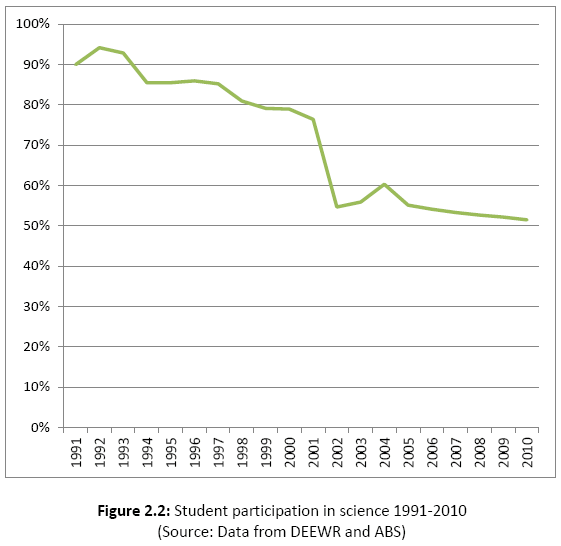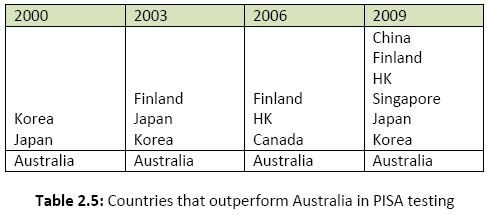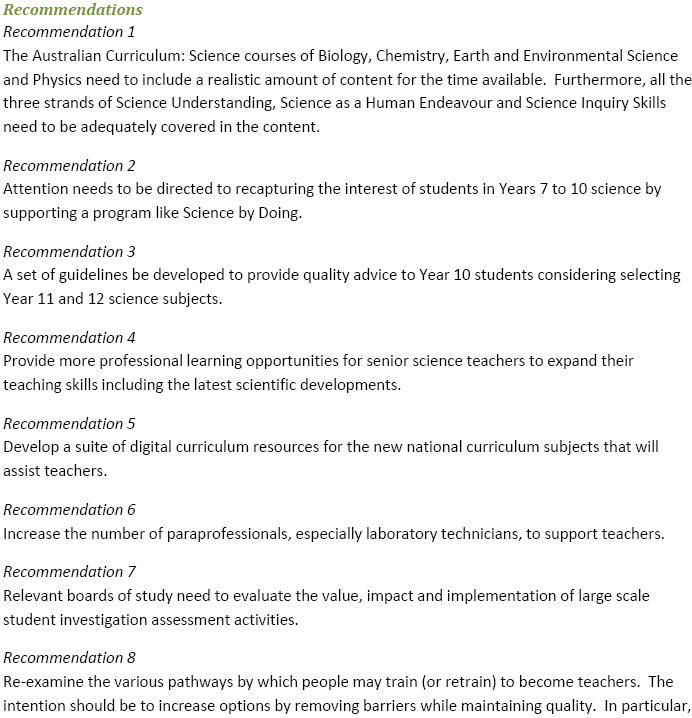|
News & Views item - December 2011 |
![]() An Apparent Simple Blunder Damps the Effect of an Australian Academy of Science
Report on Science Eduction. (December 22, 2011)
An Apparent Simple Blunder Damps the Effect of an Australian Academy of Science
Report on Science Eduction. (December 22, 2011)
The 80-page report The Status and Quality of Year 11 and 12 Science in Australian Schools was prepared for the Office of the Chief Scientist by the Australian Academy of Science and released yesterday.
With regard to the "Value of Science Education" it states that in an "ideal picture": "Science and science education are valued by the community, have high priority in the school curriculum and science teaching is perceived as exciting and valuable, contributing significantly to the development of persons and to the economic and social well-being of the nation."
However, the findings of the report are summarised as:
The Science Curriculum -- The view of teachers and students as derived from the surveys and focus groups is that Year 11 and 12 science is constructed to prepare students for university study. This university preparation perspective has resulted in an overcrowded content-laden curriculum. With the amount of content to be covered there is little room for flexibility from either the teacher or student. The science courses are perceived to be conceptually difficult with an emphasis on theoretical abstract ideas.
Science Teaching and Learning -- The content-laden curriculum encourages science in Year 11 and 12 to be taught in a traditional way using the transmission model. This approach is revealed by the fact that 73% of science students indicated that they spend every lesson copying notes from the teacher while 65% never or seldom have choice in pursuing areas of interest. Teacher demonstrations are common, with 79% of science students suggesting this occurs often, very often or always in a lesson. The practical work tends to be ‘recipe based’ with students required to follow specific instructions to achieve known results. In some states there are assessable open-ended student investigations. From the focus group discussion with teachers there was a concern about these investigations. The investigations were placing significant demands on both students and teachers.
Year 11 and 12 Science Teachers -- Science in Year 11 and 12 is taught by the most qualified and most experienced science teachers. In the telephone survey, three quarters of the interviewed teachers indicated they had a Bachelor of Science. Only 7% had no science qualifications.
Resources -- The heavy content curriculum puts significant pressure on teachers as they attempt to help their students. The most common factors that teachers listed as limiting their teaching were time (36%) and resources (23%).
The report goes on to make eight recommendations (listed below), but what appears to be a simplistic blunder has blunted the impact of the report by grossly overstating the drop in science participation between 2001-2002 (see graph), i.e. from 1992 - 2001 the reported participation in year 12 science subjects dropped from an astronomical 94% to 76% which then crashed to 55% in 2002 and has further declined slowly to 51% by 2010.

NSW Chief Scientist Professor Mary O'Kane said it appears that two different approaches were used in summarising the data: 1) from 1991 - 2001 the total enrolments in science subjects for Year 12 students was calculated while, 2) from 2002 on, the number of year 12 students studying science is recorded.
In short if you took physics and chemistry in year 12 you were one student with two enrolments and counted twice from 1991 - 2001.
Nevertheless, Professor O'Kane emphasises: "we definitely need more students studying maths and science and we are right to worry about the issue as illustrated by the trends in the... PISA data. Furthermore, in 2010 nearly half of year 12 students studied no science."



Note added January 2, 2012: Jan Thomas, Former Executive Officer for the Australian Mathematical Sciences Institute has commented to The Conversation on the question of the accuracy of data and points out: Accurate data has been a problem for a long time. Frank Barrington has solved this for mathematics by a careful analysis of the level of difficulty of the course and then using actual enrolment figures from the State authorities. The results are not good news - See: http://www.amsi.org.au/component/content/article/78-education/762-updated-year-12-mathematics-figures... [Nevertheless] It is clear we need to do more to attract students to mathematics and science.
The data that is absolutely critical to this issue relates to the quality
and quantity of teachers in these disciplines. There is no comprehensive measure
of this so the depth of the problem is not known. The cynic in me suspects that
the various educational authorities don’t want to know because they have more
than enough data to know they have a huge problem.
The problems in mathematics and science enrolments cannot be solved without
an adequate supply of knowledgeable and enthusiastic teachers in these
disciplines.
Now if we could get every parent with a child starting high school in a few weeks to ask: “Who will be teaching mathematics and what qualifications do they have for teaching it?” just maybe there would be some action.